We provide regular updates for our tagged owls, but generally the data will be at least three days old, in order to protect the owls from potential harassment. If maps for some of the linked owls are not available, we may not have had time to post them yet. Thanks for your patience!
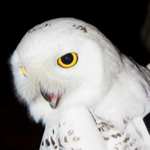 Assateague – 2013
Assateague – 2013
Updated 2/23/14 -Assateague, an immature male, was banded Dec. 17, 2013, on Assateague Island National Seashore on Maryland’s Eastern Shore, and was the first snowy owl fitted with a transmitter by Project SNOWstorm. He was a wanderer, moving more than 150 miles in a few weeks — first circumnavigating the Delaware Bay, then crossing southern New Jersey and moving north along the coast. One of the most surprising findings from Assateague’s movements were the nocturnal hunting flights he made over open water in Delaware and Barnegat bays, often using the same channel markers and buoys as nighttime hunting perches. He was last detected in mid-February, and may have suffered a transmitter failure. (©Scott Weidensaul)
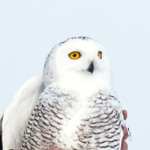 Buena Vista – 2013
Buena Vista – 2013
Updated 3/30/14 – This young male was banded Dec. 23, 2013, on the Buena Vista grasslands in central Wisconsin. In contrast to some owls, he remained within a roughly one-square-mile area throughout the winter. His location was just a few miles north of the home of the late Fran and Frederick Hamerstrom, pioneering biologists who in the 1960s organized the first major research project into snowy owl irruptions. Buena Vista was last detected March 31, 2014, still on his winter territory. (©Gene Jacobs)
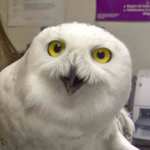 Philly – 2014
Philly – 2014
Updated 1/27/14 – Captured and tagged Jan. 9, 2014, at Philadelphia International Airport, Philly was relocated about 40 miles west to eastern Lancaster County for his own safety, as airports are dangerous for owls (and owl are a hazard to planes). However, he returned to the airport within a few days, and despite repeated efforts to recapture and relocate him a second time, Philly was struck by a plane and killed Jan. 29, 2014.. (©Scott Weidensaul)
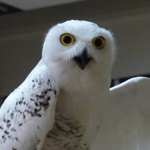 Erie – 2014
Erie – 2014
Updated 3/8/15 – Erie, an immature male, was tagged in near the Erie, PA, International Airport on Jan. 19, 2014, along with Millcreek. He was one of several snowy owls in the winter of 2013-14 that spent the majority of their time well offshore, on the frozen surface of the Great Lakes — in his case, Lake Erie — making only occasional visits to land. We assume these owls were hunting waterbirds in the ever-changing network of open-water cracks between the massive plates of wind-shifted ice covering the lakes. In spring he began moving north, first to Lake St. Clair, then up the eastern side of Lake Huron, remaining on offshore ice. He was the third owl to return from our first season, reporting in from the Bruce Peninsula on January 6, 2015.
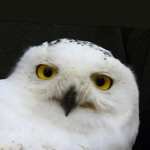 Millcreek – 2014
Millcreek – 2014
Updated 3/8/15 – Millcreek, an immature male, was tagged in Millcreek Township near the Erie, PA, International Airport on Jan. 19, 2014, along with Erie. He was one of several snowy owls in the winter of 2013-14 that spent the majority of their time well offshore, on the frozen surface of the Great Lakes — in his case, Lake Erie — making only occasional visits to land. We assume these owls were hunting waterbirds in the ever-changing network of open-water cracks between the massive plates of wind-shifted ice covering the lakes. He was last detected in late April at the east end of Lake Erie, off the Buffalo waterfront.
On Nov. 19, Millcreek checked in from southern Ontario — the first of the 2013-14 owls to return south to cell range. His stored data showed that he’d spent the summer on the eastern Ungava Peninsula in northern Quebec.
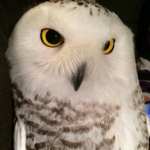 Freedom – 2014
Freedom – 2014
Updated 3/9/14 – Freedom was an immature female, tagged Jan. 25, 2014 near Appleton, WI, and named for a nearby town where she was hunting after her release. She was somewhat larger than an average female snowy owl, weighing 2,046 g (4.5 lbs.). She remained all winter in a roughly 2 mile square (3.2 km square) area, and was last detected March 9, 2014.(©Mike Lanzone)
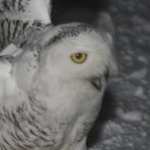 Braddock – 2014
Braddock – 2014
Updated 3/8/15 – Braddock, an immature male, was tagged Jan. 25, 2014, near Rochester New York by Tom McDonald. He spent the winter largely on the frozen surface of Lake Ontario, only occasionally coming to land, and apparently hunting for waterbirds along the ice margin. In spring he began moving northwest across Lake Ontario and up the length of Georgian Bay, then returned southeast to Lake Simcoe and Lake Ontario, before starting north again in mid-April. He was last detected April 14 in southeastern Ontario. (©Tom McDonald)
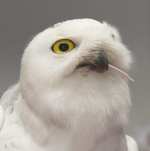 Cranberry – 2014
Cranberry – 2014
Updated 2/14/14 – Cranberry was tagged Jan. 25, 2014, near Rochester, NY, by Tom McDonald, along with Braddock, and like that owl spent much of the winter moving between land and the offshore ice of Lake Ontario. He was last detected Feb. 15, 2014, off Sodus Bay on Lake Ontario. (©Tom McDonald)
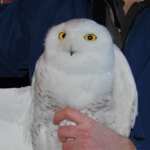 Ramsey – 2014
Ramsey – 2014
Updated 4/29/14 – Ramsey, an immature male, was tagged in his namesake town, northwest of the Twin Cities in Minnesota, on Jan. 26, 2014, by Frank Nicoletti and David Alexander. In the months that followed he remained within a fairly limited area of Ramsey, in an area with a mix of parkland, highways, commercial and residential development. In late winter he moved to the southwest, then north through the corners of South and North Dakota, across southwestern Manitoba and into eastern Saskatchewan. His last transmission was near Quill Lakes, Saskatchewan, on April 26. (©Frank Nicoletti)
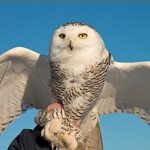 Duxbury – 2014
Duxbury – 2014
Updated 3/18/14 – Duxbury was an immature female snowy owl trapped Jan. 29, 2014, at Logan Airport by Norman Smith, and relocated to Duxbury Beach, MA, north of Plymouth. Over the next month she moved back north to Revere, just outside Boston, and was last detected there on Feb. 28, 2014. (©Raymond MacDonald)
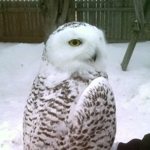 Kewaunee – 2014
Kewaunee – 2014
Updated 5/5/14 – A heavily marked immature male, Kewaunee was tagged Feb. 4, 2014, about four miles south of his namesake town in eastern Wisconsin, close to the shore of Lake Michigan, where he spent the winter hunting the open expanses of flat farmland. In early spring he moved north to the icy expanse of Green Bay, and made a long trip north to the Iron Range and back. His last transmission came May 2, 2014, from the north end of Green Bay on the Upper Peninsula of Michigan, less than 150 miles south of the last array of cell towers. (©Gene Jacobs)
 Sandy Neck – 2014
Sandy Neck – 2014
Updated 4/07/14 – Sandy Neck, an immature female, was captured Feb. 5, 2014, at Logan Airport in Boston by Norman Smith, tagged and relocated to Sandy Neck Beach near Barnstable, on Cape Cod. She eventually moved to Martha’s Vineyard for about two months, but was apparently swamped by high winds or waves in the wake of a large nor’easter while crossing open water on March 29, 2014, and drowned. She and her transmitter were recovered the next day. (Another snowy owl, Plum, also drowned in the wake of the same storm.) (©Raymond MacDonald)
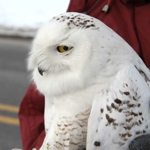 Amishtown – 2014
Amishtown – 2014
Updated 4/26/14 – Amishtown was an immature male snowy owl, captured Feb. 12, 2014, at Philadelphia International Airport and relocated 50 miles west it Lancaster County, PA. He spent the winter roaming a large large area of Lancaster County’s heavily Amish farmland, which with its lack of cover is ideal for snowy owls.
In late March he began moving rapidly north across Pennsylvania and western New York, lingering first on the south shore, then the north shore of Lake Ontario. From there he migrated northwest to Georgian Bay, which was still frozen, and his last transmission came from near Killarney, at the north end of Georgian Bay, on April 23, 2014. The cell network ends just a short distance to the north of this location.(©Scott Weidensaul)
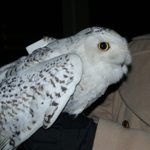 Henlopen – 2014
Henlopen – 2014
Updated 3/1/14 – Henlopen, an immature male, was banded on February 9 by Steve Huy on the beach at Cape Henlopen State Park, Delaware, and released in the same area. So far he appears to be following the same tracks that Assateague took up the around the Delaware Bay and through New Jersey. (©Steve Huy)
 Hungerford – 2014
Hungerford – 2014
Updated 5/4/14 – Hungerford, an immature female, was banded on Feb. 17, 2014, on Assateague Island, Maryland, by Steve Huy. He is named for the Hungerford House, a National Park Service cabin on the Maryland end of the island. He later flew north through Delaware to Lancaster County, PA, not far from where Amishtown was wintering, then looped back to the southeast, crossing Delaware Bay to to the coast of southern New Jersey. His last transmission was March 29, 2014, between Stone Harbor and Avalon, NJ. (©Allen Sklar)
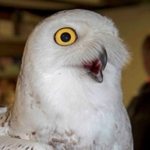 Womelsdorf – 2014
Womelsdorf – 2014
Updated 4/18/14 – Womelsdorf, an immature male, was tagged March 3, 2014, in Berks County, PA, by Scott Weidensaul. By the end of March, be migrated north across western New York, and spent several weeks on the fast-shrinking ice of central and eastern Lake Erie. His last transmission came April 17, 2014, as he was migrating north across southeastern Ontario northwest of Guelph. (©Scott Weidensaul)
 Plum – 2014
Plum – 2014
Updated 4/07/14 – Plum, an immature female snowy owl, was trapped at Logan International Airport in Boston by Norman Smith and relocated to Plum Island National Wildlife Refuge on March 4, 2014. She eventually moved up the Merrimack River valley to Haverill and Lowell, then back to the coast between Salem and Marblehead, MA. She drowned March 30, 2014, in the wake of the same large nor’easter that claimed Sandy Neck, and her remains and transmitter were recovered two days later. (©Raymond MacDonald)
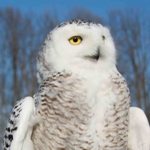 Marshfield – 2014
Marshfield – 2014
Updated 4/07/14 – Marshfield, an immature female, was tagged on March 6, 2014, in Wood County, Wisconsin by Gene Jacobs. In late winter she moved northwest to Eau Claire, then north of Minneapolis, MN, along the St. Croix River. Her last transmission came April 8, 2014, at Mille Lacs Lake, just south of the northern extent of reliable cell coverage in northern Minnesota and southern Canada. (©Gene Jacobs)
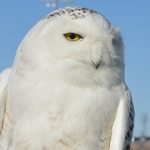 Oswegatchie – 2014
Oswegatchie – 2014
Updated 7/18/14 – Oswegatchie, an immature male named for a local creek, was tagged on March 8, 2014, in Odgensburg, New York, along the St. Lawrence River, by Tom McDonald. He spent the remainder of the winter in a small area centered on the local high school and its athletic fields.
In early April he began moving north and then west, circling through southern Ontario and Quebec in the upper St. Lawrence Valley as far west as Algonquin Provincial Park, remaining near Arnprior through much of May. June 2, 2014, he made a rapid flight about 215 miles (340 km) north to Lac Malartic in western Quebec — then settled down at the Mine Canadian in Malartic, the largest open-pit gold mine in Canada.
He transmitted data June 16, then went dark — having migrated north, we assumed. But July 18 his transmitter sent 1,200 locations, showing that he’d apparently died around June 26. His remains were recovered and necropsied, and while there was no obvious trauma or injury, it was too long after death to determine a cause. His transmitter was recovered and will be reused. (©Tom McDonald)
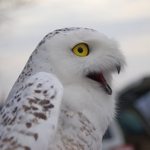 Wiconisco – 2014
Wiconisco – 2014
Updated 3/27/14 -This immature male was originally banded by Scott Weidensaul on Jan. 31, 2014, near State College, PA, where the owl was frequenting the airport. Moved by USDA Wildlife Services to Perry County, PA, Wiconisco moved 15 miles farther east on his own and was recaptured and tagged by Weidensaul March 11. He was named for Wiconisco Creek, which flows through the farming valley where he was tagged.
In mid-March Wiconisco, like several other snowy owls, moved rapidly north through Pennsylvania and western New York. He reaches Buffalo and turned around, moving southeast about 40 miles to Wyoming County, NY, where his transmitter was last in contact on March 27, 2014. (Photo ©Beth Sanders)
 Century – 2014
Century – 2014
Updated 12/1/14 – This immature female was so named for being the 100th snowy owl relocated from Logan Airport in Boston in the winter of 2013-14 by Norman Smith (who ultimately moved 120 snowy owls from Logan). Tagged March 15, 2014, she was also the largest of Smith’s owls, weighing 2,627 grams — almost six pounds.
Century was released at Plum Island National Wildlife Refuge, at the mouth of the Merrimack River in northeastern Massachusetts. She eventually began a large, circling movement south and west, through Boston, into Rhode Island and Connecticut, up the Connecticut River Valley through western Massachusetts and into eastern New York, moving back and forth between Saratoga Lake and Sacandaga Lake. Her last transmission was December 1, 2014.
She returned on November 30, 2014 reporting her summer travels in the Ungava Peninsula through mid June.
(photo ©Raymond MacDonald)
 Monocacy – 2014
Monocacy – 2014
Updated 2/18/15 – This immature female was trapped at Martin State Airport near Baltimore, MD and relocated March 16, 2014, to the Monocacy River watershed by Dave Brinker and Steve Huy. This is was Project SNOWstorm’s 22nd, and final, owl to receive a transmitter during the 2013-14 season.
Monocacy did not remain in the countryside, but immediately returned to Baltimore, where she spent the next two weeks in the downtown core of the city, sometimes flying out over the Inner Harbor but mostly hunting residential neighborhoods. Unlike our other owls, whose transmitters were programmed to collect a 3D GPS location every 30 minutes, Monocacy’s unit was collecting locations every 30 seconds. Her transmitter suddenly stopped communicating March 28, 2014 — whether because she ran afoul of an accident, or the unit failed, is unknown. (photo ©Dave Brinker)

